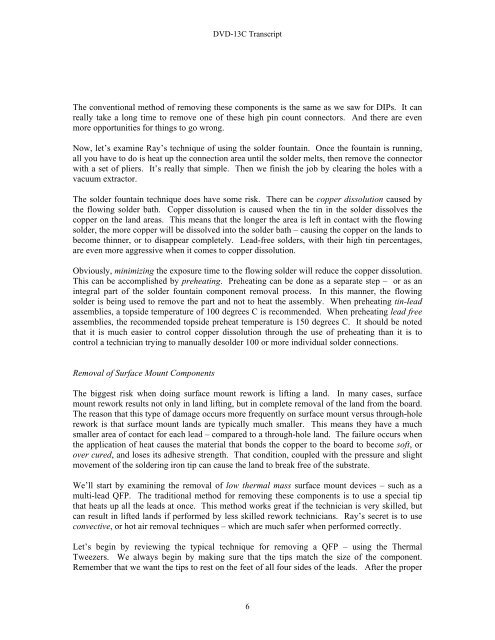You also want an ePaper? Increase the reach of your titles
YUMPU automatically turns print PDFs into web optimized ePapers that Google loves.
DVD-13C <strong>Transcript</strong>The conventional method of removing these components is the same as we saw for DIPs. It canreally take a long time to remove one of these high pin count connectors. And there are evenmore opportunities for things to go wrong.Now, let’s examine Ray’s technique of using the solder fountain. Once the fountain is running,all you have to do is heat up the connection area until the solder melts, then remove the connectorwith a set of pliers. It’s really that simple. Then we finish the job by clearing the holes with avacuum extractor.The solder fountain technique does have some risk. There can be copper dissolution caused bythe flowing solder bath. Copper dissolution is caused when the tin in the solder dissolves thecopper on the land areas. This means that the longer the area is left in contact with the flowingsolder, the more copper will be dissolved into the solder bath – causing the copper on the lands tobecome thinner, or to disappear completely. Lead-free solders, with their high tin percentages,are even more aggressive when it comes to copper dissolution.Obviously, minimizing the exposure time to the flowing solder will reduce the copper dissolution.This can be accomplished by preheating. Preheating can be done as a separate step – or as anintegral part of the solder fountain component removal process. In this manner, the flowingsolder is being used to remove the part and not to heat the assembly. When preheating tin-leadassemblies, a topside temperature of 100 degrees C is recommended. When preheating lead freeassemblies, the recommended topside preheat temperature is 150 degrees C. It should be notedthat it is much easier to control copper dissolution through the use of preheating than it is tocontrol a technician trying to manually desolder 100 or more individual solder connections.Removal of Surface Mount ComponentsThe biggest risk when doing surface mount rework is lifting a land. In many cases, surfacemount rework results not only in land lifting, but in complete removal of the land from the board.The reason that this type of damage occurs more frequently on surface mount versus through-holerework is that surface mount lands are typically much smaller. This means they have a muchsmaller area of contact for each lead – compared to a through-hole land. The failure occurs whenthe application of heat causes the material that bonds the copper to the board to become soft, orover cured, and loses its adhesive strength. That condition, coupled with the pressure and slightmovement of the soldering iron tip can cause the land to break free of the substrate.We’ll start by examining the removal of low thermal mass surface mount devices – such as amulti-lead QFP. The traditional method for removing these components is to use a special tipthat heats up all the leads at once. This method works great if the technician is very skilled, butcan result in lifted lands if performed by less skilled rework technicians. Ray’s secret is to useconvective, or hot air removal techniques – which are much safer when performed correctly.Let’s begin by reviewing the typical technique for removing a QFP – using the ThermalTweezers. We always begin by making sure that the tips match the size of the component.Remember that we want the tips to rest on the feet of all four sides of the leads. After the proper6
















